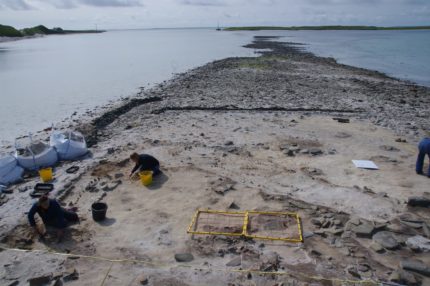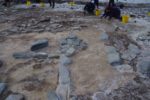 Archaeologists excavating Cata Sand, a bay on the Orkney island of Sanday, have unearthed the remains of an Early Neolithic house and at least a dozen 19th century whale skeletons. The prehistoric structure dates to between 3400 and 3100 B.C. and is fairly extensive with its original hearth and remains of walls. Northwest of the core structures is a second hearth that archaeologists believe is from a later expansion and reconstruction of the house.
Archaeologists excavating Cata Sand, a bay on the Orkney island of Sanday, have unearthed the remains of an Early Neolithic house and at least a dozen 19th century whale skeletons. The prehistoric structure dates to between 3400 and 3100 B.C. and is fairly extensive with its original hearth and remains of walls. Northwest of the core structures is a second hearth that archaeologists believe is from a later expansion and reconstruction of the house.
Prof [Colin] Richards said: “The early Neolithic house is both interesting and unusual in having been built on a deep layer of sand, which rests on rounded beach stones.
“At least two construction phases have now been recognised. The primary house has a stone set hearth, internal pits and boxes, and remains of the lower courses of a double-faced thick stone outer wall and small dividing stones, which partition the house into different living areas. This phase of the structure is comparable with examples of dwellings at Stonehall, Mainland and Knap of Howar, Papa Westray. Although excavations at Pool uncovered some early Neolithic structures in the 1980s, this is the first ‘classic’ early Neolithic house to be discovered in Sanday.”
A number of artifacts have been found in the remains of the house — pottery fragments, flint knapping debris, animal bones, Skaill knives — and they are all well preserved, which is particularly key for the bones because time, soil and the elements have chewed up organic remains at other Neolithic sites in Orkney. The rich red-brown floors in the house indicate they have a rich complement of organic remains for researchers to study in the lab.
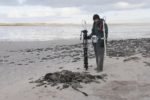 A team from the University of the Highlands and Islands Archaeology Institute (UHI), the University of Central Lancashire (UCLan) and specialists from other institutions have been excavating the site since mid-August using a geophysical survey and midden finds from a previous exploration as their guide. When the site was discovered by UHI and UCLan researchers in November of last year, their survey found evidence of a large settlement they thought might date to the Late Neolithic or Early Bronze Age (c. 2500-2000 BC). This was a transitional period which saw a great deal of social upheaval in Northern Scotland, so archaeologists were excited at the prospect of discoveries from so significant a time. If the dating on the Neolithic structure proves accurate, even though it will be earlier than expected nobody will be disappointed because it such a rare find in unusually good condition.
A team from the University of the Highlands and Islands Archaeology Institute (UHI), the University of Central Lancashire (UCLan) and specialists from other institutions have been excavating the site since mid-August using a geophysical survey and midden finds from a previous exploration as their guide. When the site was discovered by UHI and UCLan researchers in November of last year, their survey found evidence of a large settlement they thought might date to the Late Neolithic or Early Bronze Age (c. 2500-2000 BC). This was a transitional period which saw a great deal of social upheaval in Northern Scotland, so archaeologists were excited at the prospect of discoveries from so significant a time. If the dating on the Neolithic structure proves accurate, even though it will be earlier than expected nobody will be disappointed because it such a rare find in unusually good condition.
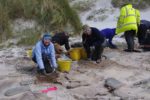 Sandy beaches are never easy to excavate, and the team has to do battle with the constant erosive action of wind and water. To top it off, the site is in the intertidal zone which means it is fully submerged twice a day. With less than a month to dig — the excavation is scheduled to end on September 8th — researchers are working assiduously to uncover as much of its archaeological material as they can.
Sandy beaches are never easy to excavate, and the team has to do battle with the constant erosive action of wind and water. To top it off, the site is in the intertidal zone which means it is fully submerged twice a day. With less than a month to dig — the excavation is scheduled to end on September 8th — researchers are working assiduously to uncover as much of its archaeological material as they can.
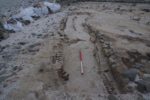 The whales are an even more unexpected find, especially so many of them. The bones have been unearthed in two large cut pits. Local traditions suggest they are the detritus of a practice known as “ca,” from a word meaning “driven,” in which whales, dozens, even hundreds at a time, were chased towards the shore until they beached themselves. There they were butchered for their blubber, a valuable source of oil that was used in lamps, motors, soaps, even margarine. It smelled terrible burning, however, and I don’t even want to know what whale margarine tastes like, so when less unpleasant replacements were invented in the 20th century, the popularity of whale oil cratered.
The whales are an even more unexpected find, especially so many of them. The bones have been unearthed in two large cut pits. Local traditions suggest they are the detritus of a practice known as “ca,” from a word meaning “driven,” in which whales, dozens, even hundreds at a time, were chased towards the shore until they beached themselves. There they were butchered for their blubber, a valuable source of oil that was used in lamps, motors, soaps, even margarine. It smelled terrible burning, however, and I don’t even want to know what whale margarine tastes like, so when less unpleasant replacements were invented in the 20th century, the popularity of whale oil cratered.
The Cata Sand site is open to visitors. If you happen to be in the Sanday area, park in the parking lot and walk the western side to the highest dune. If it’s raining they won’t be there, but otherwise you can perch on the dude and see the excavation team at work.
